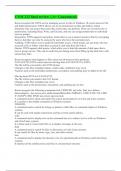CNM 232 final review || A+ Guaranteed.
Know/recognize the NTFS use for managing access to files in Windows 10 correct answers File and folder permissions: NTFS allows you to set permissions on files and folders, which determine who can access them and what actions they can perform. There are several levels of permissions, including Read, Write, and Execute, and you can assign permissions to individual users or groups.
Encryption: NTFS supports encryption, which allows you to protect sensitive files by encrypting them so that they can only be accessed by users who have the encryption key.
Auditing: NTFS allows you to audit file and folder access, which means you can track who has accessed a file or folder, when they accessed it, and what they did with it.
Quotas: NTFS supports disk quotas, which allow you to limit the amount of disk space that a user or group can use. This can be useful for preventing users from filling up the hard drive with unnecessary files.
Know/recognize what happens to files when moved between these partitions FAT16,FAT32,NTFS correct answers Moving from FAT16/FAT32 to NTFS:
The file will be converted to the NTFS format
Changes to the file's metadata (name, creation date, attributes) may occur
Features such as file and folder permissions, encryption, and auditing may be added to the file
Moving from NTFS to FAT16/FAT32:
The file will be converted to the FAT format
Changes to the file's metadata may occur
Features such as file permissions, encryption, and auditing may be lost
Know/recognize the following commands fsck, FINDSTR, and echo, find, tree, deltree, diruse,dsquery , less,set,cut,sort, mkdir,mount,fdisk,mkfs, FORMAT, CMD /F:ON, CD, CMD /F:,XCOPY, DIR, FIND, top correct answers fsck:
A command used to check and repair file system inconsistencies on Unix and Linux systems.
It is similar to the chkdsk command on Windows systems.
FINDSTR:
A command used to search for strings or patterns within files or command output on Windows systems.
It can be used with regular expressions and has several search options.
echo:
A command used to display text on the command line or to redirect text to a file on Windows and Unix/Linux systems.
It is often used to create batch files or to display messages to the user.
find:
A command used to search for files or directories on Unix/Linux systems.
It can search for files by name, type, size, and other criteria.
tree:
A command used to display the directory tree of a specified path on Windows and Unix/Linux systems.
It displays all the subdirectories and files in a hierarchical structure. deltree:
A command used to delete a directory and all its contents on Windows systems.
It is no longer available in modern versions of Windows and has been replaced by the rmdir command.
diruse:
A command used to display disk usage information for a specified directory and its subdirectories on Windows systems.
It displays the size of each subdirectory and its contents.
dsquery:
A command used to query Active Directory objects on Windows systems.
It can be used to search for users, groups, computers, and other objects in a domain.
less:
A command used to display the contents of a file on Unix/Linux systems.
It allows the user to scroll through the file and search for text.
set:
A command used to set environment variables on Windows and Unix/Linux systems.
Environment variables are used to store system or user-specific values that can be accessed by other programs.
cut:
A command used to extract specific columns or fields from a file or command output on Unix/Linux systems.
It can b
Know/recognize the commands that copy files to a disk or a usb correct answers Linux:
cp:
A command used to copy files and directories from one location to another on Linux systems.
It can be used to copy files to a USB drive or external disk.
dd:
A command used to copy and convert data from one location to another on Linux systems.
It can be used to create a bootable USB drive or to clone a disk or partition.
rsync:
A command used to synchronize files and directories between different locations on Linux systems.
It can be used to copy files to a USB drive or external disk while preserving file attributes and permissions.
scp:
A command used to securely copy files and directories between different locations on Linux systems.
It can be used to copy files to a remote server or to a USB drive or external disk.
Windows:
copy:
A command used to copy files and directories from one location to another on Windows systems.
It can be used to copy files to a USB drive or external disk.
xcopy:
A command used to copy files and directories from one location to another on Windows systems.




